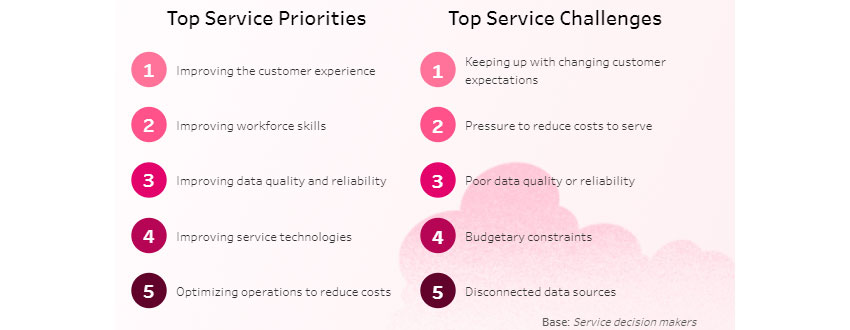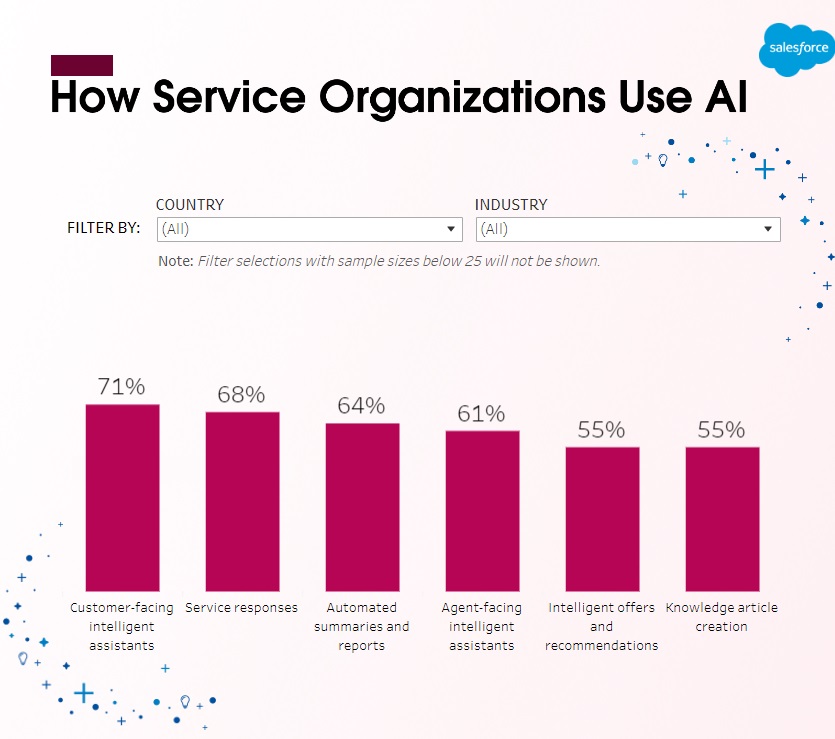A new Salesforce Customer Service Report highlights how contact center agents have become overburdened, spending “just 39 percent of their time servicing customers.”
So, what are they doing with the rest of their time?
Salesforce surveyed over 5,500 service professionals across 30 countries, who revealed that the majority of their time was being taken up by tasks such as attending internal meetings, completing administrative duties, and manually logging case notes.
Moreover, the report revealed that agents were struggling to keep up with the “mounting pressure” of increased customer expectations.
Of those surveyed, 86 percent believe that customer expectations are getting higher, while 81 percent claim that customers expect more of a personal touch.
Indeed, decision-makers identified “keeping up with changing customer expectations” as the biggest service challenge that they were currently experiencing.
The below graphic shows the top five service priorities and challenges across all countries and industries included in the research.

As you can see, there is an apparent disconnect between companies’ priorities and the reality of those agents working at the coalface.
While it is reassuring to see that organizations are prioritizing improving CX, agents clearly feel that they are not being given the adequate support and tools to achieve this.
Interestingly, two of the top five challenges concern financial pressures – supporting the trend of organizations “viewing service as a revenue driver instead of a cost center” outlined in the report.
This assertion is supported by the findings of the research, which revealed that 85 percent of service decision-makers believe that their teams are expected to up their revenue contribution this year.
Agents are expected to achieve this by upselling, cross-selling, and improving customer retention – adding a further burden to a workforce that is already struggling to keep up with customer demands.
So, with rising customer and company expectations, how do organizations plan on supporting their agents?
AI and Automation
Like Thelma and Louise, Penn and Teller, Mark and Jez, or Pie and Chips – AI and automation are fast becoming synonymous with one another.
As companies look to juggle rising customer expectations and increased agent burden, they are unsurprisingly looking to the famous customer service double act to solve their problems.
AI and automation have the potential to handle simple queries and create knowledge articles, freeing up agents to focus on more complex tasks, such as building customer relationships and resolving difficult cases.
Indeed, the Salesforce study reports that 93 percent of service professionals at organizations with AI say the technology saves them time.
The below graphic shows the most popular ways that organizations deploy AI and automation.

The report also claims that AI has the ability to “directly help with revenue generation by providing intelligent recommendations and offers to agents.”
In addition, companies are all too aware of the promise of the technology, with 79 percent of those surveyed having already invested in AI and 81 percent currently using workflow or process automation.
Looking ahead, the report predicts that these numbers will only go up, as 83 percent of decision-makers are planning to increase spending on AI and automation next year.
In discussing the section of the report that covered AI and automation, Kishan Chetan – EVP and General Manager of Salesforce Service Cloud – commented:
“Service and field service teams are getting more proactive and productive with the power of data and AI.
They’re deflecting more issues with smarter self-service. And they’re devoting more time and energy to generating revenue – pointing to a fundamental shift in their role within the business.
More News from Salesforce
As well as releasing Customer Service reports, Salesforce has made news over the past two weeks for the cooling off of its proposed acquisition of Informatica.
Reportedly, Salesforce pulled out of negotiations due to disagreements over pricing.
This comes after advanced talks had emerged, with the Wall Street Journal, at one point, reporting that a deal could be finalized before the end of last week.
However, criticism arose from Gaurav Dhillon – SnapLogic CEO and Informatica Co-Founder – who cited concerns about integrating Informatica’s technology with Salesforce’s MuleSoft platform.
There was also a response from the stock market, with both companies experiencing share price drops when the news of the potential acquisition broke, although they have since seen some recovery.







